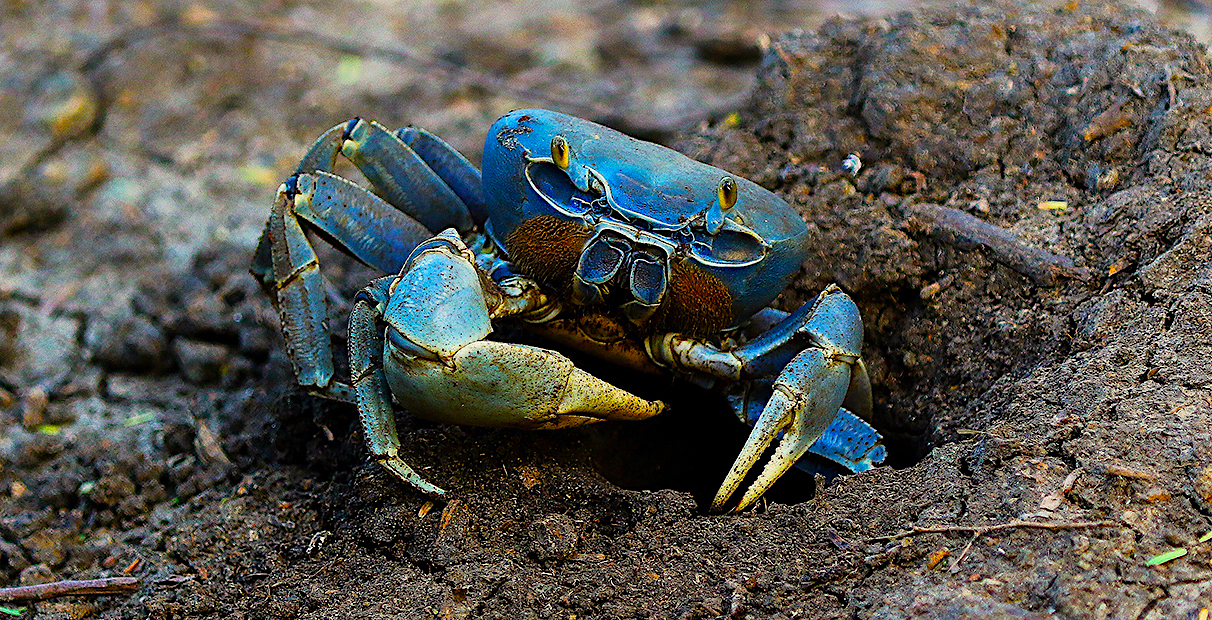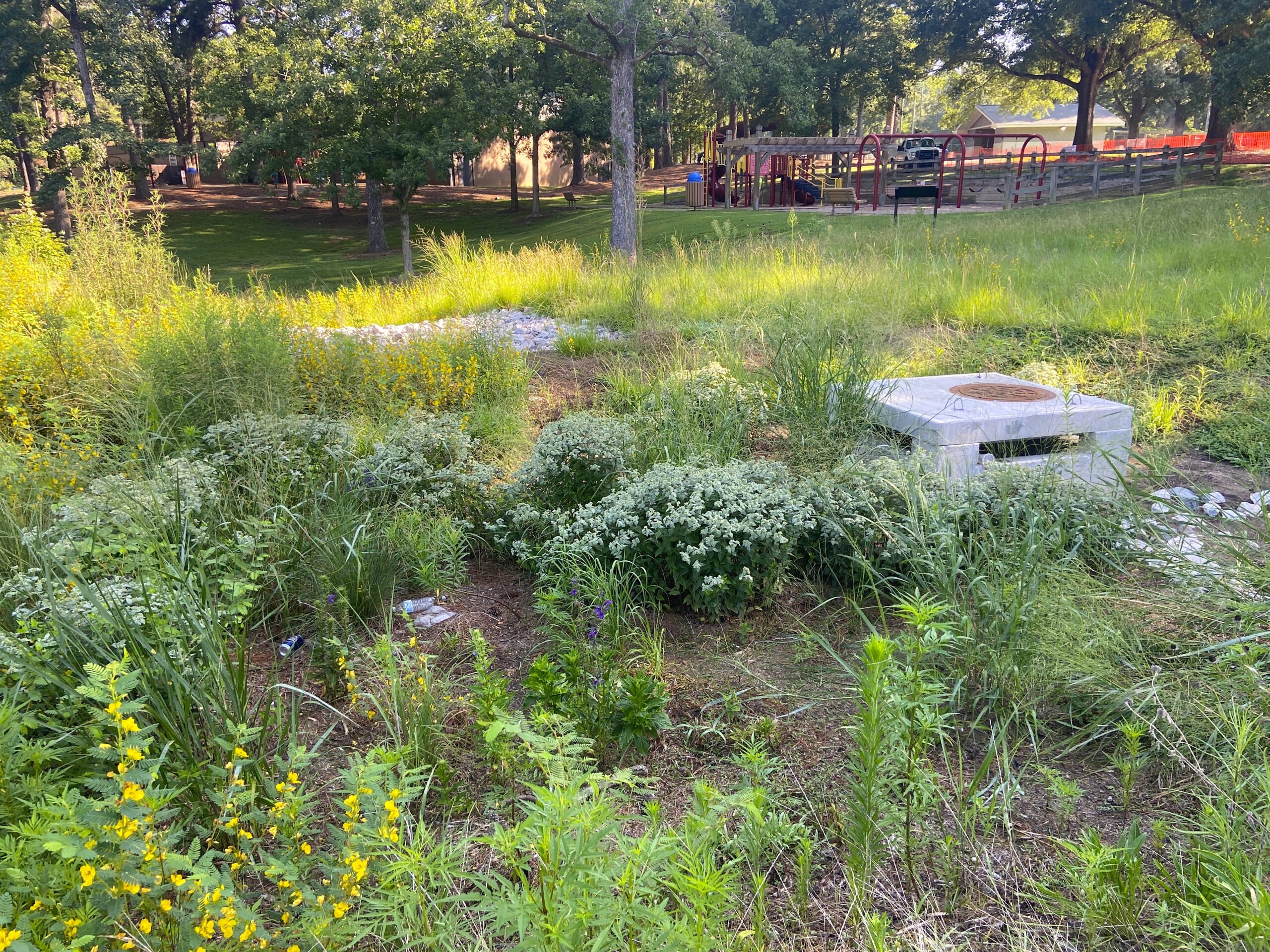BLUE CRABS, PINK TAGS: Tracking Female Crabs in the Ocean

Edna Emme is in her 80s, and she can still spot a strange fish.
“I thought I had caught a fish, but when I got it to the sand, it was something else,” Emme recalls of her March catch in Montgomery Slough. She found a “funny crab” on her fishing line.
“It was pink,” says the Oak Island resident with a laugh. Emme had reeled in a female blue crab with a fluorescent pink plastic tag.
“It looks like an ID bracelet,” says Karen Freeze, Emme’s daughter, describing the tag.
This crab is part of a project led by Elaine Logothetis, a Wilmington-based biologist.
Logothetis tags mature female blue crabs in the ocean to track their movements and determine their migratory patterns. The study is supported by North Carolina Sea Grant’s Blue Crab Research Program — which is funded by the N.C. General Assembly and administered by North Carolina Sea Grant.
And aided by bright pink tags.
“We weren’t crabbing. We were fishing,” Freeze says. “We had never seen anything like that.”
“As much as we like to eat crab, we were out fishing that day,” she adds. So mother and daughter released the crab and mailed the tag to Logothetis.
Each tag lists a phone number or a mailing address to report the find, as well as the information to provide — including capture date, location and fishing method.
The idea for the crab tagging project came from an earlier research project. In 2002 and 2003, Logothetis and fisher David Beresoff received a grant from the N.C. Fishery Resource Grant Program — also funded by the N.C. General Assembly and administered by Sea Grant — to study the feasibility of a winter conch fishery.
They used wooden conch and wire crab pots to catch whelks in the ocean. To their surprise, the traps yielded an unexpected harvest.
“We caught an awful lot of crabs,” says Beresoff, who has worked with Logothetis on several projects prior to his appointment to the N.C. Marine Fisheries Commission earlier this year.
“We were actually making more money on the crabs,” Logothetis recalls. Most of the crabs were mature females that brought in more income than the whelks.
The sheer numbers of crabs in the ocean during the winter months intrigued Logothetis. Typically, North Carolina’s main fishery for adult blue crabs is in the state’s sounds and estuaries and occurs in spring and summer.
She wondered what happened to the ocean-dwelling crabs. “That’s the mystery,” Logothetis says. “Where would they be if they weren’t harvested in the ocean?”
The crabs do not stay in the ocean permanently. After several years of ocean winter crabbing, Beresoff has discovered that crab harvest comes to an abrupt stop when the temperatures rise.
“All of a sudden, they disappear in the spring time,” he says. “We wanted to see where they went.”
Southern Migration
This is the second consecutive year that the Blue Crab Research Program is funding the tagging project.
In 2005, Beresoff and fellow fisher Tom Likos tagged almost 1,250 female crabs in the waters off Caswell and Holden beaches, as well as the Long Beach part of Oak Island, all in Brunswick County.
They tagged terminal molt female crabs — a stage where the crabs no longer shed their shells — so the crabs would not discard the tags along with their shells. Almost half of the tags were returned or reported.
This spring, supported by a second grant and the addition of fishers Dan Rimmer and Eustace Wood, the team was able to tag almost 1,300 female blue crabs in the ocean. They wanted to determine if there were variations in the catch rates of blue crabs, as well as movement patterns from year to year, Logothetis explains.
The second grant expanded the study northwards to include Topsail Island and the area around Beaufort Inlet.
“We wanted to know the composition and catch rate of ocean populations in these areas,” Logothetis says. More than 80 percent of the captured crabs were mature female crabs that move towards high salinity waters, like the ocean, to release their eggs.
The N.C. Division of Marine Fisheries (DMF) has been tagging crabs in the Cape Fear River and the Intracoastal Waterway since 2003. Stephen Taylor, DMF shellfish biologist for the southern district, says Logothetis’ research complements the ongoing studies.
While Logothetis and her team tag crabs in the ocean, DMF tags crabs “in the internal coastal waters,” he says. Taylor tagged mature female crabs bought from local commercial fishers crabbing in coastal waters, bays and the Cape Fear River.
Although most crabs are recaptured within 10 miles of the release location, some crabs are hardy travelers. Tags from Logothetis’ 2005 study were recovered from a handful of crabs in Myrtle Beach last year.
“I guess they like it down there,” Logothetis says with a laugh. “They want to shag or something,” she adds, referring to a popular Southern dance style.
“One Big Bowl of Soup”
The data from the 2005 project showed that the crabs tagged in Brunswick County moved south and southwest, riding the prevailing southward currents. “None of them ever traveled north of the Cape Fear River,” Beresoff says.
In addition, tag returns indicate that crabs not only head south, but also return to the nearest estuaries. But what causes the crabs to move into the estuaries?
“Once the temperature of the estuaries gets warmer than the ocean, the crabs start moving in,” Logothetis explains. The shallower water in the estuaries cools faster in the winter and warms up sooner in the spring than the ocean.
“Where there’s warmer water, there’s going to be more food. So they’re just following that pulse,” she adds.
Until the estuaries begin to warm up, the crabs appear to “stage” — or remain in one area in the ocean — before they re-enter the estuaries.
Dan Rittschof, a blue crab researcher at Duke University Marine Laboratory in Beaufort, has studied the migratory patterns of female crabs as they move towards high salinity waters when they are ready to spawn.
“The crabs don’t know if they’re in the ocean or in the sound,” explains Rittschof, who also has received funding from the Blue Crab Research Program. “As long as they’re in high salinity, they don’t care.”
According to Rittschof, female crabs can lay multiple clutches of eggs — up to eight clutches in 18 weeks. Spawning female crabs are known to swim on falling tides when their eggs are about to hatch. Crabs in estuaries dominated by tides end up in the ocean by late summer or early fall because they move toward the ocean with each clutch of eggs.
Mature female crabs can release eggs from early spring to early fall. Some late-maturing female crabs release only a portion of their eggs before the end of spawning season, after which they remain in the ocean for the winter.
Rittschof believes that Logothetis and her team are tagging crabs that reached the ocean during late summer and fall.
As spring — and a new spawning season — approaches and temperatures rise, the female crabs in the ocean that are still fertile start “moving back into high salinity areas in the sound,” Rittschof says. They are foraging for food in the warmer estuarine waters but still need higher salinity waters to release their larvae.
The ocean and the estuaries are one big habitat to the crabs, Logothetis explains. “They’re all just moving around like one big bowl of soup,” she says. “They’re just all mixing, depending on what they need.”
Sharing Results
“Blue crabs are the number one landed species in North Carolina,” Logothetis stresses. Blue crabs topped 2005 commercial landings in both weight and monetary value according to DMF statistics. Because of their importance to the state’s economy, the crabs need to be a well-managed and understood population.
“I think it’s important, ultimately, to know about this population and what it’s composed of,” she says.
Marc Turano, Sea Grant’s blue crab specialist, agrees. “There is virtually no data on blue crab populations in the ocean. If these projects reveal significant numbers, current sampling efforts may be missing an important component of the fishery,” he says.
Understanding blue crab movements can only help in fishery management, Turano adds.
The results of this project have already been useful to Walter Hughes, a commercial fisher from Calabash. Asked how long he has been a commercial fisher, Hughes counters with a quick laugh and a swift reply: “Forever.”
Hughes has caught about 15 of Logothetis’ tagged crabs per year for the past two years in and around Ocean Isle and Sunset Beach in Brunswick County, and in Little River Inlet, S.C. He has changed his crabbing methods based on the data from the project — especially now that he knows the direction the crabs are moving.
“For years, I thought the crabs were going north,” Hughes says. “Come to find out, they were going south.”
“I had no way of knowing before,” he adds. “At least I know where they are now.” The fishers involved in the research believe that other crabbers will benefit from the results of the study.
Beresoff says he has good catches, even when no one else is. “It makes even a bad day a good day.”
This is a worthwhile program, Hughes concludes. “I’m glad they’re doing it.”
During one of her weekend fishing trips in early June, Jackie Anderson, a Wilmington teacher, caught a tagged sponge crab — a crab with eggs — in the Lockwood Folly River.
It was an exciting find, Anderson says, although “I didn’t have my glasses on so I couldn’t read the tag.”
She called the toll-free number from her Sunset Park elementary school classroom so her fifth-grade class could learn about the tagging project too. “It was the students,” Anderson admits, “who showed me how to put [the call] on the speaker phone.” She also looked at the project’s Web site with her class.
Her students thought that capturing a tagged crab was “pretty cool.” But they were more excited about something else.
“The class was dying to know what the reward was,” Anderson recalls with a laugh. These trendy pink tags can earn $5 or $20 for the people who find them.
While Anderson’s students in Wilmington were excited about the reward, Emme was skeptical.
“I thought it was a joke,” admits the great-grandmother. So she was thrilled when a letter describing the project arrived, along with her $5.
“I gave it to my daughter and told her, ‘Go buy bait,'” she says with a chuckle.
It was a small reward in exchange for an otherwise slow day for Emme.
“I didn’t catch many fish that day.”
This article was published in the Holiday 2006 issue of Coastwatch.
For contact information and reprint requests, visit ncseagrant.ncsu.edu/coastwatch/contact/.
- Categories:


